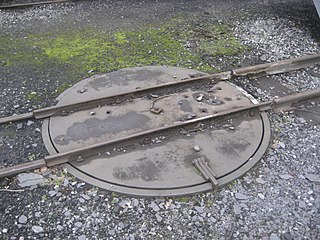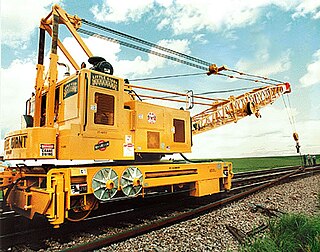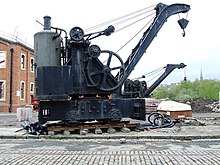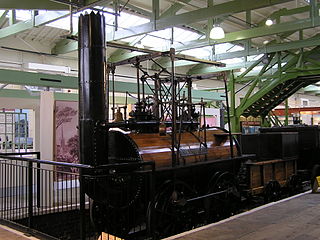
Stephenson's Rocket is an early steam locomotive of 0-2-2 wheel arrangement. It was built for and won the Rainhill Trials of the Liverpool and Manchester Railway (L&MR), held in October 1829 to show that improved locomotives would be more efficient than stationary steam engines.

A steam locomotive is a locomotive that provides the force to move itself and other vehicles by means of the expansion of steam. It is fuelled by burning combustible material to heat water in the locomotive's boiler to the point where it becomes gaseous and its volume increases 1,700 times. Functionally, it is a steam engine on wheels.

The Shay locomotive is a geared steam locomotive that originated and was primarily used in North America. The locomotives were built to the patents of Ephraim Shay, who has been credited with the popularization of the concept of a geared steam locomotive. Although the design of Ephraim Shay's early locomotives differed from later ones, there is a clear line of development that joins all Shays. Shay locomotives were especially suited to logging, mining and industrial operations and could operate successfully on steep or poor quality track.

A tank locomotive or tank engine is a steam locomotive that carries its water in one or more on-board water tanks, instead of a more traditional tender. Most tank engines also have bunkers to hold fuel; in a tender-tank locomotive a tender holds some or all of the fuel, and may hold some water also.

Puffing Billy is the world's oldest surviving steam locomotive, constructed in 1813–1814 by colliery viewer William Hedley, enginewright Jonathan Forster and blacksmith Timothy Hackworth for Christopher Blackett, the owner of Wylam Colliery near Newcastle upon Tyne, in the United Kingdom. It was employed to haul coal chaldron wagons from the mine at Wylam to the docks at Lemington in Northumberland.

The North Tyneside Steam Railway and Stephenson Steam Railway are visitor attractions in North Shields, North East England. The museum and railway workshops share a building on Middle Engine Lane adjacent to the Silverlink Retail Park. The railway is a standard gauge line, running south for 2 miles (3.2 km) from the museum to Percy Main. The railway is operated by the North Tyneside Steam Railway Association (NTSRA). The museum is managed by Tyne and Wear Archives and Museums on behalf of North Tyneside Council.

The Alderney Railway on Alderney is the only railway in the Bailiwick of Guernsey, and the only working railway in the Channel Islands. The Alderney Railway opened in 1847 and runs for about 2 miles (3.2 km), mostly following a coastal route, from Braye Road to Mannez Quarry and Lighthouse.

In rail terminology, a railway turntable or wheelhouse is a device for turning railway rolling stock, usually locomotives, so that they can be moved back in the direction from which they came. it is especially used in areas where economic considerations or a lack of sufficient space have served to weigh against the construction of a turnaround wye. In the case of steam locomotives, railways needed a way to turn the locomotives around for return trips as their controls were often not configured for extended periods of running in reverse and in many locomotives the top speed was lower in reverse motion. In the case of diesel locomotives, though most can be operated in either direction, they are treated as having "front ends" and "rear ends". When a diesel locomotive is operated as a single unit, the railway company often prefers, or requires, that it be run "front end" first. When operated as part of a multiple unit locomotive consist, the locomotives can be arranged so that the consist can be operated "front end first" no matter which direction the consist is pointed. Turntables were also used to turn observation cars so that their windowed lounge ends faced toward the rear of the train.

A railroad crane is a type of crane used on a railroad for one of three primary purposes: freight handling in goods yards, permanent way (PW) maintenance, and accident recovery work. Although the design differs according to the type of work, the basic configuration is similar in all cases: a rotating crane body is mounted on a sturdy chassis fitted with flanged wheels. The body supports the jib and provides all the lifting and operating mechanisms; on larger cranes, an operator's cabin is usually provided. The chassis is fitted with buffing (UK) and/or coupling gear to allow the crane to be moved by a locomotive, although many are also self-propelled to allow limited movement about a work site.

A steam shovel is a large steam-powered excavating machine designed for lifting and moving material such as rock and soil. It is the earliest type of power shovel or excavator. Steam shovels played a major role in public works in the 19th and early 20th century, being key to the construction of railroads and the Panama Canal. The development of simpler, cheaper diesel-powered shovels caused steam shovels to fall out of favor in the 1930s.

Marshall, Sons & Co. was a British agricultural machinery manufacturer founded in 1848. The company was based in the Britannia Iron Works, Gainsborough, Lincolnshire. Early production was of steam engines and agricultural machinery. Later production included diesel tractors such as the Field Marshall, Track Marshall and former Leyland wheeled tractors.

A motive power depot (MPD) or locomotive depot, or traction maintenance depot (TMD), is where locomotives are usually housed, repaired and maintained when not being used. They were originally known as "running sheds", "engine sheds" or, for short, just sheds. Facilities are provided for refuelling and replenishing water, lubricating oil and grease and, for steam engines, disposal of the ash. There are often workshops for day to day repairs and maintenance, although locomotive building and major overhauls are usually carried out in locomotive works.

The Fairy Queen, also known as the East Indian Railway No. 22, is a steam locomotive which was built in 1855. It was restored by Loco Works Perambur, Chennai in 1997, and housed at the Rewari Railway Heritage Museum.

Thomas Green & Son, Ltd. were engineers who manufactured a wide range of products at the Smithfield Foundry, Leeds, United Kingdom

Stothert & Pitt was a British engineering company founded in 1855 in Bath, England. It was the builder of various engineering products ranging from Dock cranes to construction plant and household cast iron items. It went out of business in 1989. The name and intellectual property became part of Clarke Chapman.

A Fairbairn crane is a type of crane of an 'improved design', patented in 1850 by Sir William Fairbairn. There are numerous hand-powered versions around the world and one surviving steam-powered example in Bristol Docks, England.

George Stephenson built a number of experimental steam locomotives to work in the Killingworth Colliery between 1814 and 1826.

Thomas Smith & Sons manufactured steam, diesel and electric powered cranes in their Old Foundry on a narrow strip of land between Town Street in Rodley near Leeds and the Leeds and Liverpool Canal.
Joseph Booth & Bros was an English company notable for making cranes used in large construction projects.






















